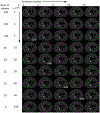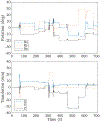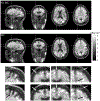Rigid Motion Correction for Brain PET/MR Imaging using Optical Tracking
- PMID: 31396580
- PMCID: PMC6686883
- DOI: 10.1109/TRPMS.2018.2878978
Rigid Motion Correction for Brain PET/MR Imaging using Optical Tracking
Abstract
A significant challenge during high-resolution PET brain imaging on PET/MR scanners is patient head motion. This challenge is particularly significant for clinical patient populations who struggle to remain motionless in the scanner for long periods of time. Head motion also affects the MR scan data. An optical motion tracking technique, which has already been demonstrated to perform MR motion correction during acquisition, is used with a list-mode PET reconstruction algorithm to correct the motion for each recorded event and produce a corrected reconstruction. The technique is demonstrated on real Alzheimer's disease patient data for the GE SIGNA PET/MR scanner.
Figures










References
-
- Rahmim A, Bloomfield P, Houle S, Lenox M, Michel C, Buckley KR, Ruth TJ, and Sossi V, “Motion compensation in histogram-mode and list-mode EM reconstructions: beyond the event-driven approach,” IEEE Transactions on Nuclear Science, vol. 51, no. 5, pp. 2588–2596, 2004.
-
- Carson RE, Barker WC, Liow J-S, and Johnson CA, “Design of a motion-compensation OSEM list-mode algorithm for resolution-recovery reconstruction for the HRRT,” in IEEE Medical Imaging Conference Proceeding, vol. 5, 2003, pp. 3281–3285.
-
- Gillman A, Smith J, Thomas P, Rose S, and Dowson N, “PET motion correction in context of integrated PET/MR: Current techniques, limitations, and future projections,” Medical Physics, vol. 44, no. 12, pp. e430–e445, 2017. - PubMed
-
- Rahmim A, Rousset O, and Zaidi H, “Strategies for motion tracking and correction in PET,” PET clinics, vol. 2, no. 2, pp. 251–266, 2007. - PubMed
Grants and funding
LinkOut - more resources
Full Text Sources
Other Literature Sources
